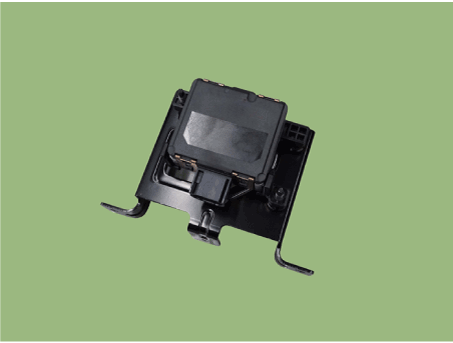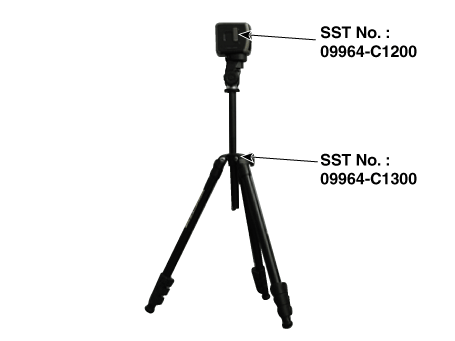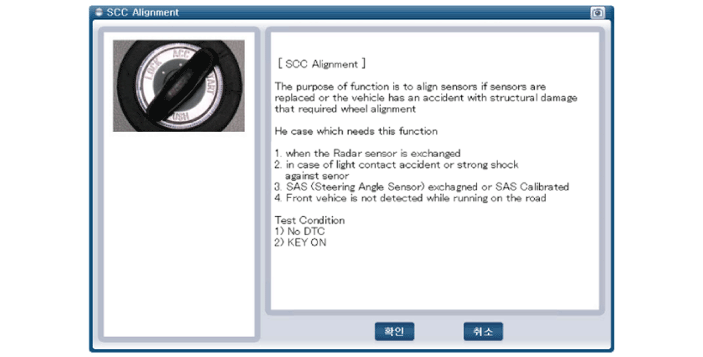Hyundai i-30: Autonomous Emergency Braking (AEB) System / AEB Radar
Repair procedures
| Removal |
| 1. |
Remove the bumper.
(Refer to Body - "Front Bumper")
|
| 2. |
Disconnect the smart cruise control unit connector (A).
|
| 3. |
Remove the smart cruise control unit assembly from vehicle after loosening
mounting nuts (A).
|
| Installation |
| 1. |
Install in the reverse order of removal.
|
| 2. |
Align the smart cruise control sensor.
(Refer to Engine Electrical System - "Smart Cruise Control(SCC) Alignment")
|
| 3. |
Install the bumper cover.
(Refer to Body - "Front Bumper Cover")
|
| AEB Radar Alignment |
The objective of the alignment is to ensure correct SCC performance. In order
for the sensor to perform correctly, the sensor must be aligned correctly. The
sensor alignment has major impact on road estimation, lane prediction, and target
processing. When the sensor is misaligned, the performance of SCC cannot be
guaranteed. Therefore, when the sensor is reinstalled or a new sensor is installed
on a vehicle, the sensor shall be aligned by service personnel.
|
|
Smart Cruise Control (SCC) Radar Alignment
| 1. |
Stop the vehicle horizontally at a flat place.
|
| 2. |
Mark the center point of emblem (A) and the center point on top of wind
glass (B).
|
| 3. |
Connect the SCC Calibration Laser (SST No. : 09964-C1200) to the Tri-Pod
(SST No. : 09964-C1300).
|
| 4. |
Match the vertical line of laser to (A) and (B) using the SCC calibration
laser pointer.
|
| 5. |
Mark (C) located in 1.0 - 3.8 m from (A) in front of the vehicle.
|
| 6. |
Disconnect the SCC Calibration Laser (SST No. : 09964-C1200) from the
Tri-Pod (SST No. : 09964-C1300).
|
| 7. |
Connect the reflector(SST No. : 09964-C1100) to the tripod(SST No. :
09964-C1300) and set the reflector center height to 583mm.
|
| 8. |
Set the reflector horizontal using the leveler which is built in the
tripod(SST No. : 09964-C1300).
|
| 9. |
Check again the radar sensor and the surface of front bumper for the
following items with the eyes.
|
| 10. |
Connect the diagnostic tool to the DLC of the vehicle and start sensor
alignment.
|
| 11. |
After correctly selecting the vehicle model, select "SCC Alignment"
from the auxiliary functions in diagnostic tool Menu.
|
| 12. |
Perform sensor alignment by following the directions shown in the diagnostic
tool monitor.
|
| 13. |
In case of sensor alignment failure, check the alignment conditions.
Turn the ignition key OFF, then reperform the sensor alignment procedure.
|
 AEB Camera
AEB Camera
Repair procedures
Removal
1.
Disconnect the negative (-) battery terminal.
2.
Remove the MFC unit cover (A)...
Other information:
Hyundai i30 (PD) 2018-2025 Service Manual: Components and components location
Component Location [Fuel Tank] 1. Fuel Tank 2. Fuel Pump 3. Fuel Fiter 4. Fuel Pressure Regulator 5. Canister 6. Fuel tank air filter 7. Fuel perssure sensor 8. Fuel pump control module (FPCM) 9...
Hyundai i30 (PD) 2018-2025 Service Manual: Emergency Call (eCall) Unit
Components and components location Component Repair procedures Removal If RED LED is on, check the eCall system with the diagnostic tools...
Categories
- Manuals Home
- 3rd Generation i30 Owners Manual
- 3rd Generation i30 Service Manual
- Theft-alarm system
- FCA sensor
- Engine coolant
- New on site
- Most important about car
Panorama sunroof
If your vehicle is equipped with a sunroof, you can slide or tilt your sunroof with the sunroof control lever located on the overhead console.

The ignition switch must be in the ON position before you can open or close the sunroof.
The sunroof can be operated for approximately 30 seconds after the ignition key is removed or turned to the ACC or LOCK(or OFF) position. However, if the front door is opened, the sunroof cannot be operated even within 30 seconds.
Copyright © 2025 www.hi30.net
















